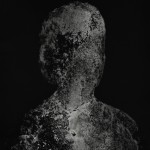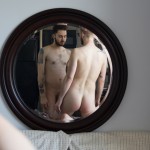DEVELOPER x Kenneth Guthrie
Kenneth Guthrie (b. 1993) earned his MFA in Photography from Columbia College Chicago in 2019. He obtained his BFA in Studio Art with a Photography emphasis from the University of Arkansas at Little Rock in 2016. Guthrie’s work explores notions of personal identity and representations of queer people through performance-based photography and video projects. His images have been exhibited nationally at Colorado Photographic Arts Center (CPAC), LATITUDE | Chicago, Massachusetts College of Liberal Arts (MCLA), and has been published in Communication Arts, PDNedu, Photographers Forum.

Amyl Nitrite (Poppers), 2018, Digital Photograph as Photo-Tex, 6″ x 9″, Edition of 5, © Kenneth Guthrie
The Way You Look at Me
Creating images of my partner and myself, I explore the nature of personal identity within an intimate relationship. The Way You Look at Me reflects upon expectations of gender expression and performativity through the lens of a queer code. I construct portraits and self-portraits possessing reciprocal and nonreciprocal gazes, calling the viewer to embody my relationship. Multiple points-of-view accompanied with gesture transform the viewing experience from voyeuristic to participatory, while atmospheric images of objects signify fleeting moments and elicit introspection. The installation emphasizes this concept as scale and vantage points vary, forcing the viewer to weave in and out of the picture plane, creating tension throughout the scene. Implementing myself as a model allows me to reference personal memories from my upbringing and the consequences of those experiences. Aware of being gay at a young age, I struggled with either accepting my true identity or conforming to masculine/feminine expectations that came with growing up Southern Baptist. I would sneak into my mother’s bedroom to wear a dress or high heels, but felt pressure to wear straight-legged jeans with plaid button-ups to construct straightness for safety from everyday life. By engaging in multiple acts of self-fashioning, I question the role of representation and true identity within photography and how this influences the act of looking at others.
Slim Non-Masc Faggot Bundles Faggots
Through the bundling of sticks – which results in a faggot – I question the word used to describe people and objects, its etymology and evolution throughout history, as well as its weight within contemporary culture. Slim Non-Masc Faggot Bundles Faggots is a performance video where I repeatedly select and bundle sticks to form faggots. The title of the scene references language used within gay culture mostly by white cis-gay men when navigating sex. In the 19th century, women made an insufficient living off gathering sticks to make fires at home, gaining the title “faggot-gatherer.” In the past, many household acts such as doing the dishes, folding the laundry, or repetitive household chores have been considered more feminine tasks. I use repetition as a traditionally femme act to reclaim the activity of bundling and challenge traditional gender roles within society. Using light to place emphasis on the delicacy of the nude body and its gestures when selecting sticks or tying knots, I also address standards of beauty and desire within the gay community. In the video I curate which sticks will be grouped together, breaking some down to make them fit with a particular group. These careful selections mixed with aggressive searching speak to the criticalness and unrealistic expectations gay men can place onto others to fuel their physical needs.
Brennan Booker: Hi there! Thanks so much for taking the time to speak with me today. I’ve been a fan of your work for quite some time and I’m so pleased to be able to interview you for the newest installment of DEVELOPER.
Kenneth Guthrie: Hey Brennan! Thank you for taking the time to interview me, I’m very excited to be included in the DEVELOPER project! I love your work and I’m glad we can talk to each other!

Rich in Baby-Pink Lipstick, 2018, Archival Inkjet Print, 12″ x 18″ framed, Edition of 5, © Kenneth Guthrie
BB: I want to first start by asking about the role that your partner, Rich, plays in the image making process. How much entry does he have into your creating process, and how does that dynamic in turn affect the work?
KG: When I initially began making my project The Way You Look at Me, it started with a Polaroid camera being passed back-and-forth between myself and Rich. We would make nude snapshots of each other and direct each other’s gazes, poses, and the overall scene. The decision to photograph my partner definitely came intuitively and I felt that I needed to follow that instinct, but I also kept in mind how important it was for me to maintain his agency in the images. Since we both make images and have a relationship with photography, we collaborated in ways that made us both comfortable yet vulnerable.
All of the images, which are based on my personal experiences, are created in my head and then sketched if needed. Before I made an image that included Rich, I would discuss my vision with him, set limits, and then schedule the shoots. when Rich is in that scene I usually give him the remote to release the shutter when he feels comfortable. This allows him to feel in control of his body, the experience, and that’s what I think creates that highly intimate mood in my image while still being constructed or staged. It’s also important that I make sure my partner is comfortable having his likeness on display in exhibitions or publications. Since I’m also making nude images of him, I make sure to discuss and communicate my intentions with the pictures before we make anything.
I think our openness and willingness to be honest and vulnerable makes the work highly intimate although being completely performed. Since Rich knows and understands that my intentions are not to exploit or take advantage or himself or our relationship, I’m able to fully realize my vision as well as keeping his authorship within the images. It’s a great collaboration with my subject, and I’m really happy about that.
BB: One of the things I find really interesting in the essay that you published alongside this work is how your upbringing has not only affected the images you’re creating but your larger image making practice as a whole. Would you feel comfortable elaborating on that? How have the people who grew up with you, and know you as straight jean plaid wearing Kenneth reacted to the work, and how do you have conversations with them about this kind of subject matter? Do you have any advice for other LGBTQ+ artists trying to explore their identity/sexuality in their work who aren’t sure how to have those conversations with the people looking at their work?
KG: Absolutely. When I first started making work in graduate school, I was (and still am) really focused on subverting toxic masculinity, queering the gaze, and making sex-positive images. Growing up Southern Baptist, I was always reminded that sex before marriage was “not good.” On top of punishing myself for my natural desires, I internalized a lot of negative feelings and began to project myself as more masculine or straight to the public. This is something I’m still trying to resolve even now. As a way of working through this insecurity, passing back-and-forth that Polaroid camera became an important journey to have. This allowed me to connect with sex, with my partner, but overall, with myself as a queer man.
When I tried exploring my sexuality through the medium of photography back home in Arkansas, it was hard to find support or maintain conversations around queer art, artists, and anything LGBTQIA+. I struggled in undergraduate critiques to get feedback or support, and also didn’t find it in my familial relationships. It definitely could have been a mix of being unfamiliar to the topic as well as against discussing such matters, but I put that work on hold and made work about the death of my father instead. I have always been an artist that makes work about their personal experiences, and I feel that a lot of the stories I have can be shared across the spectrum of the queer community.
I think if I could give any advice it would be to give yourself and others time. Eventually, if you revisit a problem and persistently work at it, you will resolve it. My mother, although I’m sure she doesn’t quite understand everything that I do, fully supports me now. It took time, but I think my dedication to my craft and content really shined through when she saw the work at my MFA Thesis exhibition. And as for fear of rejection, don’t let it consume you. When I came to Chicago and had my first critique at Columbia, I was told my work wasn’t gay enough. You will find your tribe, and it will be truly rewarding.
BB: I’m really intrigued by the way you’ve chosen to display your work in the gallery setting. I find this continuation of the overlapped hanging style tradition reminiscent of incredible artists like Wolfgang Tilmmans to be really visually stimulating. What kind of conversations are you creating and hoping the viewer has by controlling the physicality of the prints?
KG: Tillman’s way of installing definitely came up in my research. I knew I wanted to work with Photo-Tex, the vinyl sticker-like material in my show, ever since I walked into the Museum of Contemporary Photography on my first day of work and saw Alexandre Haefeli’s images printed on the material. The way skin was referenced in the actual installation of the work intrigued me. There was a giant image of a close-up profile with a couple of fingers in the mouth. There was saliva and freckles and so much detail that really lended well to the material. I work with a lot of clothing and patterns in my work, so I use the Tex material and frames to create a tension between the ethereal and physical, but to also create narrative and relationship between singular images. A lot of the images in my project can stand alone, however other rely on pairing and installation to really get my point of view across. Working with vantage point, I also make images with third-person narratives. This creates spectatorial engagement through bodily experiences that involve the photographer, subject, and viewer. Through subject-to-camera distance, body language, and gaze, I allow my viewer to enter the story, becoming an interloper, participant, or voyeur. The installation emphasis this concept because image sizes vary, the placement is high and low, and it really forces viewers to move around the space and really get involved, join the story. I was thinking a lot about the relationship between the bodies on the wall and the bodies in the space and how they navigate each other.

Installation at 2019 MFA in Photography Exhibition, Columbia College Chicago, © Jonathan M. Castillo

Installation at 2019 MFA in Photography Exhibition, Columbia College Chicago, © Jonathan M. Castillo

Installation at 2019 MFA in Photography Exhibition, Columbia College Chicago, © Jonathan M. Castillo
BB: Let’s talk about Slim Non-Masc Faggot Bundles Faggots. The language both in the title and visually in this piece really speaks to the contemporary experience of anonymity and queerness. The intersection of appropriated text and sound from dating apps, alongside the repetitious and vulnerable nature of the action you’re engaging in is really an ambitiously multi-faceted piece. Is this your first performance-based piece, and how do you feel like it’s influencing the work outside of just the still image?
KG: Slim Non-Masc Faggot Bundles Faggots is a performance film that has gone through many different stages of refining. I have omitted the use of the audio excerpts from Grindr profiles and conversations I originally started using. Now, the video is silent with ambient noise, focusing on the delicacy the hand gestures, the dramatic form of the body, and the repetitive nature of the task at hand. There are a few instances where I break a few sticks, disrupting the audio and visuals of the scene. The title itself alludes to language men use on dating apps to describe their build for others who are looking for sexual encounters.
And yes, this is my first video-performance debut, if you will. Columbia’s program incorporates video classes, which is very important and changed my practice. I think that while Slim Non-Masc Faggot Bundles Faggots was made separately from The Way You Look at Me, they both speak a lot about similar things. Desire, Binaries, the Other. I think displaying these works together allows weight to be added to the discussion I want to start around the words we use to describe people and how we project stereotype. For example, bringing the sticks into the space and installing them in a way that created a mound that you don’t see until you turn around really surprised my viewers, and made the work palpable.

Still from Slim Non-Masc Faggot Bundles Faggots, 2019, Single Channel Video with Audio, 10 minute loop, © Kenneth Guthrie
BB: As a fellow gay man, I know that my lived experience allows me to access a lot of the same emotional and visual metaphors that you’re working within your work. For people who might fall outside of the gay man field of world-view, how do you engage with people who don’t know how to approach your work, or who maybe don’t have the context needed to immediately pick up on the visual language you utilize?
KG: I think my experience as a museum educator really helps me when it comes to educating others who might not know how to approach or understand my work. I really enjoy doing panel discussions about my work and research with colleagues as well as artist talks at art centers or institutions. The artist statement is really important to my practice. I know some people will read it and some people will not, but with that statement, I really discuss my overall concerns and themes employed and try to talk about it in a general sense for others to understand. I also employ an intimate and tender approach to my image making. Initially, I was trying to go for shock, but I found it shuts people off, and overt attempts come across as unsuccessful most of the time. Creating tender depictions of two queer men in my work I feel allows for more comfortable reading, but I also believe that installation space and where the work is shown definitely has an impact on how individuals will interpret or interact with the work. I also feel that getting the work out there on as many different platforms help. Sharing publications and interviews with friends and family allows them to get new insight into the work since I delve deeper into a conversation surrounding it. I think being an advocate for the work allows different people to engage with it.
BB: Now, I know you just finished your MFA at Columbia Chicago, and what an incredible accomplishment that is! What’s on the horizon for you now? Do you have any advice for people who are trying to decide whether a graduate program is right for them?
KG: Thank you very much! I am very happy to be done however very sad I won’t have a close-knit group of people every day! It’s definitely bittersweet. Right now, I’m looking for work in museum education, collections, and/or curatorial projects. I have a passion for public programming, and would really love to pursue a career in museum programming. As far as making new work goes, I’m sketching and slowly thinking of new work, while submitting these projects for publication and exhibition opportunities.
Some advice that I have when it comes to looking at graduate schools is to do your research! What are the students making? What do the faculty do? Are there TA opportunities? Financial help? Is there a museum you can work at or other professional opportunities while in school? Do they bring in visiting artists? Are they traditional or experimental in their curriculum? I think all of these things are important, but I want to emphasize looking at the works of students and faculty. You will be working with them literally every day for two to three years. If you’re not excited about it, I would listen to those feelings.

Left: Rich in Floral Romper, 2018, Archival Inkjet Print, 20″ x 28″ framed, Edition of 5, © Kenneth Guthrie Right: Chemise, 2018, Digital Photograph as Photo-Tex, 36″ x 57″, Edition of 5, © Kenneth Guthrie

Top: Mother’s Tongue, 2018, Archival Inkjet Print, 12″ x 18″ framed, Edition of 5, © Kenneth Guthrie —- Bottom: Rich Lying on Bed, 2018, Archival Inkjet Print, 30″ x 20″ framed, Edition of 5, © Kenneth Guthrie
BB: Thank you so much for speaking with me about your body of work, The Way You Look At Me. I can’t wait to see what you make next, and happy Pride Month!
KG: Thank you and Happy Pride!
Keep up with Kenneth Guthrie at:
https://www.kennethguthrie.com/
Instagram: @kennethguthrie
–
Click here to see more posts from the developer series.
Posts on Lenscratch may not be reproduced without the permission of the Lenscratch staff and the photographer.
Recommended
-
DEVELOPER x Kenneth GuthrieJune 13th, 2019
-
DEVELOPER x Xu GuanyuApril 8th, 2019
-
Developer x For FreedomsMarch 21st, 2019
-
Developer: Rana Young: The Rug’s TopographyJanuary 30th, 2019
-
Brennan Booker: HoneysuckleJanuary 29th, 2019




































































